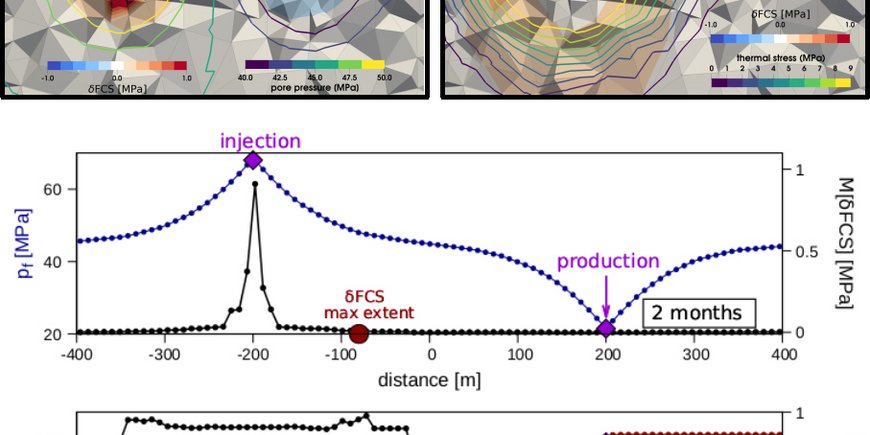Summary
In connection with underground work - for example to develop geothermal reservoirs or other resources - undesirable seismic activities such as shaking or minor earthquakes may occur. Therefore, it is crucial to improve the prediction of such induced seismic hazards. Current statistical approaches only consider the increase in pore pressure as a major physical effect. Scientists from the German Research Centre for Geosciences (Deutsches GeoForschungsZentrum Potsdam GFZ) and the Free University of Berlin (FU Berlin) recently presented a novel mathematical model in the journal Scientific Reports that generalizes the assumed statistics for use in arbitrary injection and production constellations and that can be applied to arbitrary physical processes. With this, they were also able to show how different injection and production measures influence the seismic hazard and that controlled injection protocols can effectively reduce the induced seismic risk.
Generalization of a successful model
Since its first publication by co-author Serge Shapiro in 2010, the seismogenic index model has been successfully applied to forecast the induced seismic hazard at a variety of sites worldwide. The success of this theory stems from its relatively simple mathematical formulation of what is indeed a complex problem, that is, the induced seismic risk or a reservoir is characterised by means of a dimensionless constant with a clear physical meaning. The current formulation assumes pore pressure variations, including in more recent works poro-elastic effects, as the main driver of induced earthquakes, and efforts among the dedicated community have been towards generalizing the SI model to other than pore fluid diffusion processes while maintaining the same level of simplicity and wide range of applicability of the original formulation.
In this study, Mauro Cacace and Hannes Hofmann, German Research Center for Geosciences Potsdam (GFZ), and Serge Shapiro, Free University Berlin, have generalised the SI model for use in arbitrary physics and operation protocols with relevance for induced seismicity. In the new model, seismicity is driven by a normalized integral over the spatial reservoir volume of induced variations in frictional Coulomb stress (derived from an underlying reservoir model), which – combined with the seismogenic index – provides a dimensionless proxy of the induced seismic hazard. “Our model can be described as a hybrid physics-based- and statistical-forecasting model, which incorporates and extends the range of application of the classical pressure diffusion based and poroelastic SI models”, says Mauro Cacace, Group Leader in the GFZ section Basin Modelling.
Application to geothermal systems and reassessment of seismic hazard
Applying the model to geothermal systems, Cacace and his colleagues found that the induced seismic hazard is sensitive not only to pressure magnitudes but also to imposed pressure rates, as also constrained by recent laboratory experiments. “We demonstrated how irregularities and the non-monotonic character of injection/production protocols can strongly impact induced seismicity and its hazard, and that controlled injection protocols can effectively decrease the induced seismic risk”, sums up Cacace.
Furthermore, the researchers demonstrated that non-linear, quasi-static thermo-poroelastic stress transfer results in a systematic increase in the seismic response of stimulated rock (higher induced magnitudes) that extends over a larger volume and a longer time scale (larger seismic footprint) than classical pore-pressure-relaxation dynamics would imply. “This calls for caution when assessing seismic hazard: if such complex physical interactions are not considered, it can only provide conservative lower-bound hazard estimates”, explains Hannes Hofmann, leader of the Helmholtz Young Investigator Group "Advanced reservoir engineering concepts for a controlled utilization of deep geothermal energy in urban areas" (ARES) in the GFZ section Geoenergy and Juniorprofessor at TU Berlin. „In this regard, our novel approach provides a valuable addition to ATLs which are based on passive observations of seismicity before terminating injection by demonstrating how to actively project induced seismicity as a function of the stimulation scheme.”
Calculation of expected seismicity and further applications of the new model
The new approach offers the possibility to use information – the tectonic seismogenic index – obtained during a particular stimulation by history matching of field data to project expected seismicity that could be induced by another type of underground operations on the same reservoir. Additionally, the model can be used to identify optimal injection strategies to mitigate potential seismic hazards from planned operations and to test the applicability of novel concepts for forecasting and controlling induced earthquake hazards.
In the here presented study, the authors have limited themselves to applications for geothermal reservoirs. However, the flexibility of the model allows for broader applications of subsurface operations and/or to be extended for use in natural earthquakes, in which faults are loaded by a transient stress source that can be described (as usually done) in terms of FCS variations.
Original publication: M. Cacace, H. Hofmann, S. A. Shapiro, Projecting seismicity induced by complex alterations of underground stresses with application to geothermal systems. Scientific Reports, 11, 23560 (2021), DOI: 10.1038/s41598-021-02857-0
Scientific contact:
Dr. Mauro Cacace
Group Leader Section 4.5 Basin Modelling
Helmholtz-Zentrum Potsdam
Deutsches GeoForschungsZentrum GFZ
Telegrafenberg
14473 Potsdam
Tel: +49 331 288-1783
E-Mail: mauro.cacace@gfz-potsdam.de
Prof. Dr. Hannes Hofmann
Group Leader Section 4.8 Geoenergy
Helmholtz-Zentrum Potsdam
Deutsches GeoForschungsZentrum GFZ
Telegrafenberg
14473 Potsdam
Tel: +49 331 288-28739
E-Mail: hannes.hofmann@gfz-potsdam.de
Media contact:
Dr. Uta Deffke
Public and Media Relations
Helmholtz Centre Potsdam
GFZ German Research Centre for Geosciences
Telegrafenberg
14473 Potsdam
Phone: +49 331 288-1049
Email: uta.deffke@gfz-potsdam.de




![[Translate to English:] Eine Frau mit weißem Kopftuch und ein Mann mit dunklen Haaren sitzen vor mehreren großen Computerbildschirmen mit Messdaten und Karten.](/fileadmin/_processed_/7/f/csm_20241221_PM-GITEWS_Abb0_Kachel_2b4cf3de2f.jpeg)







![[Translate to English:] [Translate to English:] Abror Gafurov von dem Schriftzug "Welcome to Azerbaijan" und den UN und COP Logos](/fileadmin/_processed_/2/5/csm_2024_11_Baku_COP29_Abror_Gafurov_1042faec82.jpeg)


![[Translate to English:] Martin Herold standing in front of the library on the Telegrafenberg](/fileadmin/_processed_/c/d/csm_Martin_Herold_d385ee4dd9.jpeg)
![[Translate to English:] Many people are listening to a presentation in the GFZ lecture hall.](/fileadmin/_processed_/c/a/csm_1_Bild1_hell_b9c0e9f5ed.jpeg)






![[Translate to English:] Both scientists sitting on stools in front of a wall of books in the Telegrafenberg library](/fileadmin/_processed_/6/6/csm_Buiter_Castell_DORA_4_e87cb1ea18.jpeg)
![[Translate to English:] Gruppenbild mit 4 Personen](/fileadmin/_processed_/8/d/csm_20241017_GFZ-Emmerman-Medal-005_web_reinhardtundsommer_21a414fa4a.jpeg)






![[Translate to English:] Ice landscape with five red tents](/fileadmin/_processed_/8/9/csm_Zeltlager_auf_dem_Eis_Urheberin_Jenine_McCutcheon_5ced2d523b.jpeg)

